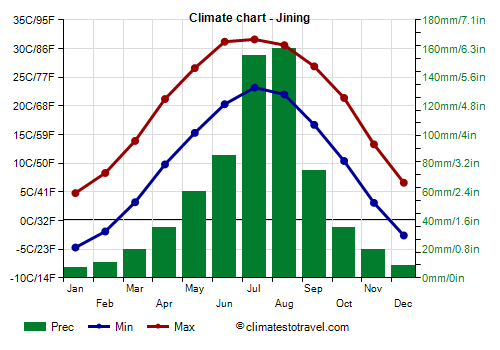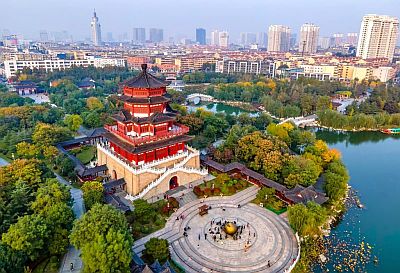Select units of measurement for the temperature and rainfall tables (metric or imperial).
Average weather, temperature, rainfall, sunshine hours

The climate of Jining is
continental, with cold, dry winters and hot, humid summers.
The city is located in the southwestern part of Shandong Province, in north-central China, at 35 degrees north latitude.
To the south is Nanyang Lake, the northernmost of four connected lakes (the others being Dushan, Zhaoyang and Weishan).
Here are the average
temperatures.
Jining - Average temperatures (1981-2010) |
| Month | Min | Max | Mean |
|---|
| January | -4.7 | 4.8 | 0 |
|---|
| February | -1.9 | 8.3 | 3.2 |
|---|
| March | 3.2 | 13.9 | 8.6 |
|---|
| April | 9.8 | 21.2 | 15.5 |
|---|
| May | 15.3 | 26.6 | 21 |
|---|
| June | 20.3 | 31.2 | 25.8 |
|---|
| July | 23.2 | 31.6 | 27.4 |
|---|
| August | 22 | 30.6 | 26.3 |
|---|
| September | 16.7 | 26.9 | 21.8 |
|---|
| October | 10.4 | 21.4 | 15.9 |
|---|
| November | 3.1 | 13.3 | 8.2 |
|---|
| December | -2.6 | 6.6 | 2 |
|---|
| Year | 9.6 | 19.8 | 14.65 |
|---|
amounts to about 670 millimeters (26 inches) per year. Owing to the monsoon regime, the rainiest season is summer, while the driest is winter. Here is the average precipitation.
Jining - Average precipitation| Month | Days |
|---|
| January | 7 | 3 |
|---|
| February | 10 | 4 |
|---|
| March | 20 | 5 |
|---|
| April | 35 | 7 |
|---|
| May | 60 | 7 |
|---|
| June | 85 | 11 |
|---|
| July | 155 | 12 |
|---|
| August | 160 | 10 |
|---|
| September | 75 | 7 |
|---|
| October | 35 | 6 |
|---|
| November | 20 | 4 |
|---|
| December | 8 | 4 |
|---|
| Year | 670 | 79 |
|---|
, from December to February, is cold and dry: the average January temperature is 0 °C (32 °F), but sunny days are quite frequent. Precipitation is rare and not abundant, however, given the low temperatures, there may be some snowfalls, generally light.
The north wind can bring cold waves, with minimum temperatures around -10 °C (14 °F) or below, as well as the dust of the Gobi Desert. In January 2016 and in January 2021, the temperature dropped to -16 °C (3 °F).
On other occasions, especially in December and February, there may be quite mild periods, with maximum temperatures around 15 °C (59 °F).
In
spring, from March to May, the temperature increases, while rainy days become gradually more frequent. In March and April, the clash between air masses can cause sand storms. In May, there may already be very hot days, especially at the end of the month.
Summer, from June to August, is hot and muggy; owing to the Asian monsoon, it is the rainiest season (actually, it is the only really rainy season). June is already a hot month, but rainfall and muggy heat generally start in July, or during the month of June. However, the rains display an erratic pattern from year to year. The amount of sunshine is fairly good, but considering the length of the days, it is slightly lower than in the other seasons. The rains occur mainly in the form of downpours or thunderstorms.
The periods of good weather during summer can be very hot, with highs around 38 °C (100 °F), and in these cases, the heat does not give relief even at night. In July 2002, the temperature reached 40.7 °C (105.5 °F).
Usually, August is not as hot as June and July, but it is more sultry.
Autumn, from September to November, is initially warm, and gradually becomes milder, and then quite cold by November, but it can sometimes get cold at night already in October. The rains decrease and become rare enough.

From July to early October (and occasionally also in the second half of June), Jining can be affected by
typhoons, the tropical cyclones of South-East Asia, although this area of China is less exposed than the south.
Best Time
The
best times to visit Jining are spring and autumn, ie from the end of March to mid-May and from mid-September to the end of October. In April and October, at night, it can sometimes be cold, with lows around freezing.